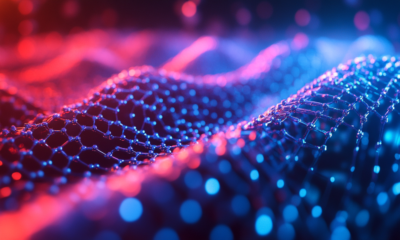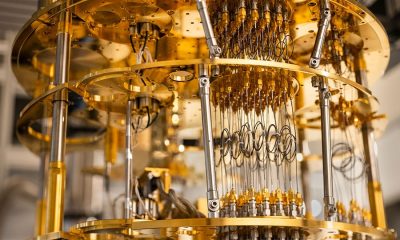Inteligencia Artificial
Entrenamiento de IA con fibra óptica: un salto basado en la luz
Securities.io mantiene rigurosos estándares editoriales y podría recibir una compensación por los enlaces revisados. No somos asesores de inversiones registrados y esto no constituye asesoramiento de inversión. Consulte nuestra divulgación de afiliados.

Why Optical Fiber Could Replace Electricity in AI Computing
Desde los primeros días de informática, almost all computers have been based on calculations using electricity in one way or another, from antique vacuum tubes to modern nanometer-scale silicon chips.
As silicon chips get smaller and smaller, researchers have been looking at new ways to build computers that could push our capacity further than silicon chips, a topic we explored in “Las 10 principales empresas de informática sin silicio.
These methods include using different materials, like carbon carbide, vanadium dioxide, organic materials, or graphene, for example. Another way is to change how computing is done, moving away from the binary programming of electricity-based computing, which includes quantum computing and photonics.
Photonics uses light instead of electricity to encode and transfer information. However, until now, it has still been ultimately converted into a binary signal, failing to form a purely light-based form of computation.
This has changed with the work of researchers at the Tampere University (Finland) and Université Marie et Louis Pasteur (Besançon, France). They used optical fiber for ultrafast calculations and published their findings in the scientific journal Optics Letters1, bajo el título "Limits of nonlinear and dispersive fiber propagation for an optical fiber-based extreme learning machine.
Limitations of Traditional AI Training With Electronic Systems
AI training and data processing are reaching limits in terms of efficiency, with AI computation increasingly constrained by energy consumption and the speed of data processing.
In contrast, light-based calculations have the potential to be thousands of times quicker and can encode data into tiny differences of energy, making it more efficient. The issue is that so far, no direct calculation using light has been performed.
The researchers' work used a particular class of computing architecture known as an Extreme Learning Machine, (ELM) an approach inspired by neural networks.
Among some of their advantages, ELMs can learn from the training data in one step and are a relatively simple algorithm.
As a rule, ELM is unlikely to be useful for very complex tasks requiring multiple layers of AI training, but can perform very well and more efficiently for specific tasks, like visual recognition for example.
How Researchers Encoded Images Using Optical Fibers
The researchers used femtosecond laser pulses (a billion times shorter than a camera flash) and an optical fiber confining light in an area smaller than a fraction of human hair to build an optical ELM system.
The laser pulses are short enough to contain a large number of different wavelengths or colors, creating a rich dataset.
They then sent these data into the fiber with a relative delay encoded according to an image.

Fuente: Universidad de Tampere
The Role of Nonlinear Optics in AI Processing
This form of data encoding was transformed by the nonlinear interaction of light and glass.
Linear optics is the regular optics taught in school, where the light directly interacts with a prism, for example.
En óptica no lineal, la reacción del medio por el que pasa la luz depende de la longitud de onda, la intensidad, la dirección y la polarización de la luz.
Nonlinear optical components can cause photons of different frequencies to combine and create new photons at new frequencies.
“Instead of using conventional electronics and algorithms, computation is achieved by taking advantage of the nonlinear interaction between intense light pulses and the glass.”
Mathilde Hary and Andrei Ermolaev – Post-Doctoral Researchers
Non-linear interaction and Extreme Learning Machine (ELM) algorithm was able to train an AI to classify handwritten digits (like those used in the popular MNIST AI benchmark).

Fuente: Cartas ópticas
The best systems reached an accuracy of over 91%, close to the state-of-the-art digital methods.
What makes the result exceptional is that it was achieved in under one picosecond, or one trillionth of a second (0.000000000001 seconds).
Ideal Optimization
The best results did not occur at the maximum level of nonlinear interaction or complexity.
Instead, they required a delicate balance between fiber length, dispersion (the propagation speed difference between different wavelengths), and power levels.
“Performance is not simply matter of pushing more power through the fiber. It depends on how precisely the light is initially structured, in other words how information is encoded, and how it interacts with the fiber properties.”
Are Optical Fiber Computers the Future of AI?
Training AIs with only light is a radical departure from all the methods used until now. This is likely not going to be a method possible to use for every type of data, but for the ones where it can be applied, this could bring results that are 1,000x more efficient in terms of energy, and as much as a million times quicker.
“Our models show how dispersion, nonlinearity and even quantum noise influence performance, providing critical knowledge for designing the next generation of hybrid optical-electronic AI systems.”
Most likely, such an approach would mean that some AI calculation would be delegated to a non-linear optical fiber hardware custom-built for the task. So repetitive tasks, like visual identification, would be the best candidates more than processing new data.
“This work demonstrates how fundamental research in nonlinear fiber optics can drive new approaches to computation. By merging physics and machine learning, we are opening new paths toward ultrafast and energy-efficient AI hardware.
Potential applications range from real-time signal processing to environmental monitoring and high-speed AI inference.
Such work is, however, still at the demonstration of basic principles of the technique stage, and far from a commercialization step.
It nevertheless demonstrates that photonics is likely going to be an increasingly important part of the computing industry moving forward, as light can be superior to electricity for some computing applications due to fundamental physics reasons.
Top Publicly Traded Laser & Photonics Company
Coherente (II-VI Marlow):Un líder en innovación láser
coherente, inc. (COHR + 4.21%)
Coherent es un gran conglomerado industrial con más de 26,000 empleados y líder en tecnología láser. Surgió de la fusión de Advanced Material II-VI Marlow con el fabricante de láseres Coherent.
La empresa es experta en materiales avanzados utilizados en láseres, óptica y fotónica, como fosfuro de indio, obleas epitaxiales y arseniuro de galio.
It grew largely thanks to multiple acquisitions over the last decade, from $600M in revenues in 2013 to $4.7B in 2024.
The company derives 29% of its revenues from lasers directly, with the rest linked to associated equipment like optical fiber, and electronics. The instrumentation category mostly includes life
sciences and medical applications.

Fuente: Coherente
La presencia de la empresa en materiales avanzados como la termofotovoltaica (que discutimos en un artículo anterior), silicon carbide, lasers, and electronics helps it benefit from structural trends like the growth of precision manufacturing, additive manufacturing (3D printing), electrification, and renewable energies.
La compañía tiene Recientemente separó su negocio de carburo de silicio en una nueva entidad, propiedad en un 75% de Coherent, y el resto es propiedad en partes iguales de sus socios Mitsubishi Electric (que aporta propiedad intelectual sobre carburo de silicio) y Denso (que aporta su actividad como proveedor de automoción en electrificación y semiconductores de potencia).
Esto se debe a que el carburo de silicio es cada vez más una tecnología propia, utilizada principalmente en aplicaciones de alta potencia, como vehículos eléctricos, baterías y energía renovable.
Coherent es un líder en LIDAR y detección digital 3D, incluidas aplicaciones de conducción autónoma, biotecnología Celdas de flujo para secuenciación de próxima generación (NGS) y Láseres para la fabricación de semiconductoresEspera que sus principales mercados crezcan entre un 8 y un 20%.

Fuente: Coherente
The other potential new applications of lasers, like direct energy weapons, photonic computing, nuclear fusion, and spacetech, could all equally help sustain the long-term growth of the company.
En general, Coherent es lo más cercano que puede llegar a ser una empresa de láser “pure play” que cotiza en bolsa para los inversores interesados en el sector, con una fuerte integración vertical y más de 3,100 patentes que protegen sus innovaciones.
As photonics progresses, it will progressively increase the demand for ultra-fast, ultra-precise laser systems, as well as lasers used in optical telecommunications.
Últimas noticias y desarrollos de acciones de Coherent (COHR)
Estudio referenciado
1. Andrei V. Ermolaev, Mathilde Hary, Et al. Limits of nonlinear and dispersive fiber propagation for an optical fiber-based extreme learning machine. Cartas de óptica. Vol. 50, Issue 13, pp. 4166-4169 (2025) https://doi.org/10.1364/OL.562186















